Way back in September my brother posted this challenge in a post:
Since I have been on a roll with the topic of High Speed Rail lately I thought I would give a proper response as to what I will be bringing back in the Spring of 07...
Here Goes...
I'm Bringin' High Speed Back
*Yeah*
It will make up for what the Midwest Lacks
*Yeah*
From Minnesota to Chi-Town in under 3 hours flat
*Yeah*
take it to the platform...
Get your HSR, that's High Speed Rail baby, Get your HSR, go ahead get goin' with it, get your HSR, that's High Speed Rail, Get your HSR
180 Miles per Hour that's how fast it goes
*Yeah*
So you better hang onto your clothes
*Yeah*
Just watch that Bullet Train just come and Go
Get your ticket and take it to the station...
Get your HSR, that's High Speed Rail baby, Get your HSR, go ahead get goin' with it, get your HSR, that's High Speed Rail, Get your HSR
So that's what I am bringing back, the rails shall rise again from the ashes. If anyone would like to help me make a vid for this I think it would be sweet and worth a laugh for a presentation.
Monday, January 29, 2007
Tuesday, January 23, 2007
All right Senior Thesis: Game On
I touched on this topic at the beginning of the New Year, but here are some thoughts that have materialized in the past few days with my Senior Thesis Writing Seminar:
Possible Topics:
Too often I have used European examples of High Speed Rail; Not this time, the above image is of the Nozomi Series 500 Shinkansen in Japan from Bullet Trains. According to sources on Wikipedia, The Nozomi can reach speeds of 320km or 200 MPH, but is currently only operating at a maximum of 300 km or 186 MPH.
1) The Need for High Speed Rail (HSR) in the Midwest.
The idea came to me while I was on Study Abroad participating in the Scandinavia Urban Studies Term (SUST) through HECUA last semester. It was very easy and reasonably priced to get on a long-haul train and go from Oslo-to-Bergen in roughly 6 hours. At the end of my term, I attended a conference on the development of High Speed Rail (HSR) corridors in Norway that included High Speed proposals with service from Oslo-to-Trondheim and Oslo-to-Bergen.
This got me curious as to why the United States did not have a High Speed Rail network and what was being done in the field. Over break I began reading a few sources, particularly High Speed Rail Policy for the 21st Century by Anthony Pearl and read over the 2004 Executive Report of the Midwest Regional Rail System
My paper would be similar to these sources of looking at European HSR applications and then determining policy solutions, amounts of financing and sources of financing, as well as feasibility for applications in the Midwest to connect to HSR networks pre-existing predominantly in the Northeast corridors (Acela, formerly the Metroliner).
Another picture of the Nozomi 500 Series Shinkensen
2) I-494 Transitway Study
This topic would directly relate to my internship at the State Capitol with Rep. Ann Lenczewski and is a topic that is directly related to the Twin Cities MSA and the South Metro. This would be a preliminary model study of transit options for the I-494 Corridor including: BRT, LRT, and possibly PRT. This study would then be used to inform Rep. Ann Lenczewski to propose legislation for funding of a true study conducted by the Metropolitan Council.
Through my internship I will have contact with major stakeholders involved in the study. However, since there has been no formal study of transit along I-494, it may be difficult to find sources directly related to this topic.
And yet another question, which of these topics would you choose, and which one in your opinion would help Minnesota and the Midwest the most?
Whichever way it goes it should be a fun semester and a interesting senior thesis. Wish me luck.
Possible Topics:
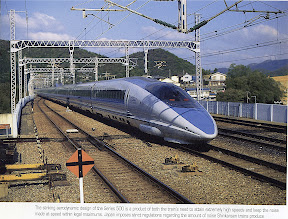 |
| From Blog Photos |
Too often I have used European examples of High Speed Rail; Not this time, the above image is of the Nozomi Series 500 Shinkansen in Japan from Bullet Trains. According to sources on Wikipedia, The Nozomi can reach speeds of 320km or 200 MPH, but is currently only operating at a maximum of 300 km or 186 MPH.
1) The Need for High Speed Rail (HSR) in the Midwest.
The idea came to me while I was on Study Abroad participating in the Scandinavia Urban Studies Term (SUST) through HECUA last semester. It was very easy and reasonably priced to get on a long-haul train and go from Oslo-to-Bergen in roughly 6 hours. At the end of my term, I attended a conference on the development of High Speed Rail (HSR) corridors in Norway that included High Speed proposals with service from Oslo-to-Trondheim and Oslo-to-Bergen.
This got me curious as to why the United States did not have a High Speed Rail network and what was being done in the field. Over break I began reading a few sources, particularly High Speed Rail Policy for the 21st Century by Anthony Pearl and read over the 2004 Executive Report of the Midwest Regional Rail System
My paper would be similar to these sources of looking at European HSR applications and then determining policy solutions, amounts of financing and sources of financing, as well as feasibility for applications in the Midwest to connect to HSR networks pre-existing predominantly in the Northeast corridors (Acela, formerly the Metroliner).
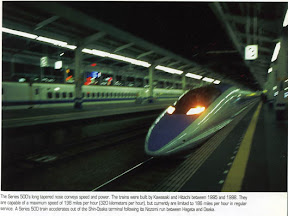 |
| From Blog Photos |
2) I-494 Transitway Study
This topic would directly relate to my internship at the State Capitol with Rep. Ann Lenczewski and is a topic that is directly related to the Twin Cities MSA and the South Metro. This would be a preliminary model study of transit options for the I-494 Corridor including: BRT, LRT, and possibly PRT. This study would then be used to inform Rep. Ann Lenczewski to propose legislation for funding of a true study conducted by the Metropolitan Council.
Through my internship I will have contact with major stakeholders involved in the study. However, since there has been no formal study of transit along I-494, it may be difficult to find sources directly related to this topic.
And yet another question, which of these topics would you choose, and which one in your opinion would help Minnesota and the Midwest the most?
Whichever way it goes it should be a fun semester and a interesting senior thesis. Wish me luck.
Photo Contest Time
Got word today in am email from the University of Minnesota Learning Abroad Center of a mighty important contest coming up in February:
2007 INTERNATIONAL PHOTO CONTEST
WIN GREAT PRIZES!
Past sponsors have included Rail Europe, STA Travel, Lonely Planet, Rough Guides, and more!
Top 10 photos chosen by popular vote at the Learning Abroad Spring Fair, February 21. Global Link members will determine final winners.
Official Rules:
1. Contest is open to University of Minnesota undergraduate and graduate students only.
2. Photo must have been taken outside of the U.S.
3. Photo must have been taken by the person submitting the photo.
4. Only one photo entry per person.
5. Entries must be color or black and white prints 4" x 6". Digital prints will be accepted only if they are unaltered. E-mailed submissions will not be accepted.
6. Photos will not be returned. Please submit copies of your photo only.
7. The top ten photos will be determined by public vote at the Spring Learning Abroad Fair on February 21st in the Great Hall of Coffman Memorial Union.
8. Winners will be notified via email and must respond to claim their prize by Friday, March 2nd.
So, to help me decide which of my photos from Scandinavia are of the highest quality, contest winning quality ;-), I consulted a former winner; Franky J with his photo from Australia.
See more of his photos at his flickr page.
The following - which have been posted on this blog in other posts are his personal suggestions.
His first pick: My Personal Favorite as well, Pulpit Rock in the Lysefjorden Towering at 604 Meters (And as an update: The one I submitted this morning...February 13th, 2007)
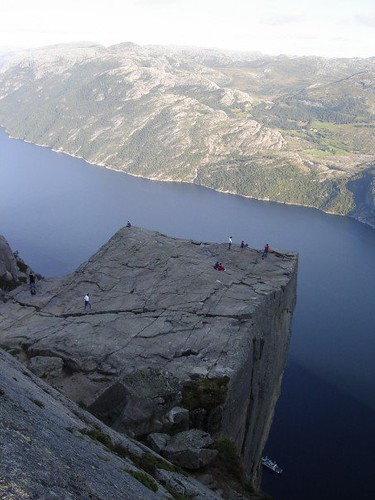
His Second: Along the Oslo-Bergen Railway, one of the most beautiful railways labled by National Geographic Traveler in 2004
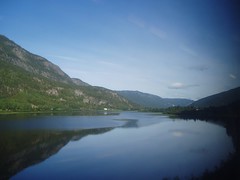
His Third: Eyes Glued to the Window

Fourth: If cropped right...
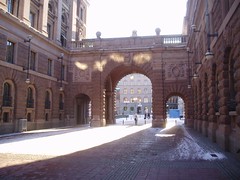
My parent's Personal Favorite is of the kids in the T-Bahn which is another one of my favorites and has appeared many times on this little blog.

That's all for recommendations for now from Family and the brother, but I am wondering what some of my readers (I know there are a few of you out there) would recommend. I sometimes like to add tasks to the end of my blogs, and this one is pretty easy, pick your favorite photo from the Scandinavian Set on my flickr page (link below my profile) and let me know or leave a comment at flickr (if your a member of course).
Deadline is the 15h, so I got some time, which means you (the readers) do too.
I look forward to the comments and thanks Frank for the help.
2007 INTERNATIONAL PHOTO CONTEST
WIN GREAT PRIZES!
Past sponsors have included Rail Europe, STA Travel, Lonely Planet, Rough Guides, and more!
Top 10 photos chosen by popular vote at the Learning Abroad Spring Fair, February 21. Global Link members will determine final winners.
Official Rules:
1. Contest is open to University of Minnesota undergraduate and graduate students only.
2. Photo must have been taken outside of the U.S.
3. Photo must have been taken by the person submitting the photo.
4. Only one photo entry per person.
5. Entries must be color or black and white prints 4" x 6". Digital prints will be accepted only if they are unaltered. E-mailed submissions will not be accepted.
6. Photos will not be returned. Please submit copies of your photo only.
7. The top ten photos will be determined by public vote at the Spring Learning Abroad Fair on February 21st in the Great Hall of Coffman Memorial Union.
8. Winners will be notified via email and must respond to claim their prize by Friday, March 2nd.
So, to help me decide which of my photos from Scandinavia are of the highest quality, contest winning quality ;-), I consulted a former winner; Franky J with his photo from Australia.
See more of his photos at his flickr page.
The following - which have been posted on this blog in other posts are his personal suggestions.
His first pick: My Personal Favorite as well, Pulpit Rock in the Lysefjorden Towering at 604 Meters (And as an update: The one I submitted this morning...February 13th, 2007)

His Second: Along the Oslo-Bergen Railway, one of the most beautiful railways labled by National Geographic Traveler in 2004

His Third: Eyes Glued to the Window

Fourth: If cropped right...

My parent's Personal Favorite is of the kids in the T-Bahn which is another one of my favorites and has appeared many times on this little blog.

That's all for recommendations for now from Family and the brother, but I am wondering what some of my readers (I know there are a few of you out there) would recommend. I sometimes like to add tasks to the end of my blogs, and this one is pretty easy, pick your favorite photo from the Scandinavian Set on my flickr page (link below my profile) and let me know or leave a comment at flickr (if your a member of course).
Deadline is the 15h, so I got some time, which means you (the readers) do too.
I look forward to the comments and thanks Frank for the help.
Tuesday, January 09, 2007
Now I have to read the book :-D
As the previous post states, I have been talking a lot about the film Children of Men. I have since learned that it was originally a book by P.D. James, a British detective author, and that the book was not in the category of apocalyptic science fiction.
Here's an article from the NY Times comparing the book to the film dated December 28th
Source: Proquest Newsstand
Author: Caryn James (Times Select $$)
Copyright New York Times Company Dec 28, 2006
to view the article online (must be a member or have access from other accounts)
No one should have to choose between Clive Owen and P. D. James. As an alcoholic, unshaven hero in a totalitarian near-future, Mr. Owen holds together the ominous yet vibrant new film ''Children of Men,'' adding to his list of brooding, darkly handsome characters (notably in ''Closer''). But while this Alfonso Cuaron film is inspired by the 1992 James novel, the movie is so purely cinematic, and its plot departs so widely from the book's, that the screen version may obscure how wonderfully rich and unlikely that novel is.(which is why I want to read it)
''The Children of Men'' is not another of Ms. James's famed detective novels, and it is not, as it has sometimes sloppily been described, science fiction. It is a trenchant analysis of politics and power that speaks urgently to this social moment, a 14-year-old work that remains surprisingly pertinent.(Was that the director's intent, to bring focus back to this "pertinent" piece of literature that has faded into obscurity?) Mr. Cuaron and Mr. Owen have made a film that works superbly apart from the book, but Ms. James's extraordinary novel deserves to be rediscovered on its own.
In both forms ''Children of Men,'' which opened Monday (in select cities, others had to wait until after New Years), is a story of redemption, set in England just decades in the future (the film takes place in 2027), when women have inexplicably lost the ability to become pregnant. Utterly cynical, Theo (Mr. Owen) is drawn into a group trying to protect a woman who has, just as inexplicably, become pregnant and whose child is likely to be used for the despotic government's own purposes.
Ms. James couldn't have foreseen some details the film uses to create a future frighteningly like today: a government department called Homeland Security; a crawl at the bottom of the omnipresent video screens that says, ''Terror Alert: Extremely High.''(not so sure about that, the book was written shortly after the first Gulf War with Iraq, not to mention some terrorists events of the Reagan Era of Iran Contra and the Beirut Marine Bombings, but of course not to the scale of which we see today)
But the social problems she could spot in 1992, like immigration, are even more disturbing now because they are more topical. A member of the novel's ruling Council of England makes a comment that could come from a right-wing radio show in America today. ''Remember what happened in Europe in the 1990s?'' he says. ''People became tired of invading hordes,'' who expect to ''exploit the benefits which had been won over centuries by intelligence, industry and courage.''
Those prescient social themes give the book its resonance, and are far more important than the deft way the movie streamlines the novel: Theo, an Oxford historian in the James version, is a minor bureaucrat in the film's Ministry of Energy; Julianne Moore's character, who enlists his help in protecting the pregnant woman, combines two people from the novel, Theo's ex-wife and a former student he scarcely knows.
As she does so gracefully in her mysteries, in ''The Children of Men'' Ms. James creates a beautifully realized world, making fine points the film has no time for(and is worse off because of those details left out): childless women push dolls in baby carriages, and couples hold christening ceremonies after the births of kittens.(imagine some of the scenes that could have been used for this, not more than a couple of seconds)
And Theo recalls boyhood summers as the poor relation visiting his rich, supremely self-confident cousin, Xan, a character who as an adult holds the title warden of England and is, in fact, the country's dictator. On screen this character, called Nigel and played by Danny Huston, has only one scene, when Theo tries to use this connection to get a travel visa for the pregnant woman.
Moviegoers may wonder why this character pops up at all, or why such an elaborate set was created; we see that he owns Picasso's ''Guernica'' and Michelangelo's ''David,'' whose leg has been damaged. The episode feels shoehorned into the movie, which isn't surprising in a work with five credited screenwriters and a nine-year gestation(five!!??). Even after Mr. Cuaron became interested, in 2001, he went off to direct ''Harry Potter and the Prisoner of Azkaban'' before returning to the project, which was then altered to suit the post-9/11 world.
Despite those topical additions, Xan is a huge lost opportunity for the film, because he is the vehicle for Ms. James's astute exploration of how certain kinds of tyrants come to exist. The social disorder and pessimism that Ms. James defines so sharply -- science has failed to explain, much less cure, the infertility, and religion is a solace to some but a gaping hole to others -- has allowed this despot to seize control. Parliament is a sham that, as Theo says, ''gives the illusion of democracy,'' and the members of Xan's ruling Council never disagree with him.
This poisonous rule is presented to the public and accepted as a strong, desirable response to threats to the country. The government justifies abuses in the name of a smoothly run society: it condones the forced, slavelike labor of immigrants and encourages the mass suicides of the old. As a Council member explains: ''What we guarantee is freedom from fear, freedom from want, freedom from boredom. The other freedoms are pointless without freedom from fear.''
That line becomes even more haunting now that the world feels more threatening and freedom has become a buzzword applied to everything from the ludicrous anti-French Freedom Fries to the sober Freedom Tower planned for the World Trade Center site.
The personal motives behind Xan's tyranny are also shrewdly analyzed. Theo asks the once apolitical Xan why he became Britain's ruler, and Xan answers in the cavalier manner we recognize from his boyhood, ''At first because I thought I'd enjoy it,'' adding, ''I could never bear to watch someone doing badly what I knew I could do well.'' By the time power had lost its thrill, he claims, no one in the Council was competent to take over.
When Theo calls him on this self-delusion, Xan replies, ''Have you ever known anyone to give up power, real power?''
Theo fully grasps this explanation and carries its lesson to the underground group that hopes to overthrow Xan's tyranny. ''If you did succeed, what an intoxication of power,'' he says.
That warning comes back to haunt the entire novel, and it's a theme the film could have put to fuller use. In its second half the screen version of ''Children of Men'' all but abandons its social concerns. (We see that immigrants have been forced into camps, but how and why?) It becomes a thoughtful chase movie. And even with Mr. Owen's tough yet stirring performance, Theo is more conventional on screen. Like the film character, the book's Theo has also lost a small child, but he has been responsible for the death, no state for a movie hero to be in.
When the film loses its energy for politics and its taste for ambiguity, that makes the difference between a good movie and an exceptional one. (There are lesser reasons; was it necessary for two characters actually to say, ''Jesus Christ'' when learning of the near-miraculous pregnancy and birth?)
The ending of the novel is brilliantly ambiguous and entirely different from the film's, as the potential for the ''intoxication of power'' falls into unexpected hands. As Ms. James said in an interview when the book came out: ''The detective novel affirms our belief in a rational universe because, at the end, the mystery is solved. In 'The Children of Men' there is no such comforting resolution.'' It is comforting for both moviegoers and readers, though, to have Clive and P. D. as the season's best odd couple.
Author(s): Caryn James
Column Name: Film
Section: E
Publication title: New York Times. (Late Edition (East Coast)). New York, N.Y.: Dec 28, 2006. pg. E.1
Source type: Newspaper
ISSN: 03624331
ProQuest document ID: 1186984861
Text Word Count 1236
I plan on finding this book as soon as I have finished the others that are stacked upon my desk, see the movie, read the book, or the other way around and let me know what you think, I'd like to hear people's thoughts.
Here's an article from the NY Times comparing the book to the film dated December 28th
Source: Proquest Newsstand
Author: Caryn James (Times Select $$)
Copyright New York Times Company Dec 28, 2006
to view the article online (must be a member or have access from other accounts)
No one should have to choose between Clive Owen and P. D. James. As an alcoholic, unshaven hero in a totalitarian near-future, Mr. Owen holds together the ominous yet vibrant new film ''Children of Men,'' adding to his list of brooding, darkly handsome characters (notably in ''Closer''). But while this Alfonso Cuaron film is inspired by the 1992 James novel, the movie is so purely cinematic, and its plot departs so widely from the book's, that the screen version may obscure how wonderfully rich and unlikely that novel is.(which is why I want to read it)
''The Children of Men'' is not another of Ms. James's famed detective novels, and it is not, as it has sometimes sloppily been described, science fiction. It is a trenchant analysis of politics and power that speaks urgently to this social moment, a 14-year-old work that remains surprisingly pertinent.(Was that the director's intent, to bring focus back to this "pertinent" piece of literature that has faded into obscurity?) Mr. Cuaron and Mr. Owen have made a film that works superbly apart from the book, but Ms. James's extraordinary novel deserves to be rediscovered on its own.
In both forms ''Children of Men,'' which opened Monday (in select cities, others had to wait until after New Years), is a story of redemption, set in England just decades in the future (the film takes place in 2027), when women have inexplicably lost the ability to become pregnant. Utterly cynical, Theo (Mr. Owen) is drawn into a group trying to protect a woman who has, just as inexplicably, become pregnant and whose child is likely to be used for the despotic government's own purposes.
Ms. James couldn't have foreseen some details the film uses to create a future frighteningly like today: a government department called Homeland Security; a crawl at the bottom of the omnipresent video screens that says, ''Terror Alert: Extremely High.''(not so sure about that, the book was written shortly after the first Gulf War with Iraq, not to mention some terrorists events of the Reagan Era of Iran Contra and the Beirut Marine Bombings, but of course not to the scale of which we see today)
But the social problems she could spot in 1992, like immigration, are even more disturbing now because they are more topical. A member of the novel's ruling Council of England makes a comment that could come from a right-wing radio show in America today. ''Remember what happened in Europe in the 1990s?'' he says. ''People became tired of invading hordes,'' who expect to ''exploit the benefits which had been won over centuries by intelligence, industry and courage.''
Those prescient social themes give the book its resonance, and are far more important than the deft way the movie streamlines the novel: Theo, an Oxford historian in the James version, is a minor bureaucrat in the film's Ministry of Energy; Julianne Moore's character, who enlists his help in protecting the pregnant woman, combines two people from the novel, Theo's ex-wife and a former student he scarcely knows.
As she does so gracefully in her mysteries, in ''The Children of Men'' Ms. James creates a beautifully realized world, making fine points the film has no time for(and is worse off because of those details left out): childless women push dolls in baby carriages, and couples hold christening ceremonies after the births of kittens.(imagine some of the scenes that could have been used for this, not more than a couple of seconds)
And Theo recalls boyhood summers as the poor relation visiting his rich, supremely self-confident cousin, Xan, a character who as an adult holds the title warden of England and is, in fact, the country's dictator. On screen this character, called Nigel and played by Danny Huston, has only one scene, when Theo tries to use this connection to get a travel visa for the pregnant woman.
Moviegoers may wonder why this character pops up at all, or why such an elaborate set was created; we see that he owns Picasso's ''Guernica'' and Michelangelo's ''David,'' whose leg has been damaged. The episode feels shoehorned into the movie, which isn't surprising in a work with five credited screenwriters and a nine-year gestation(five!!??). Even after Mr. Cuaron became interested, in 2001, he went off to direct ''Harry Potter and the Prisoner of Azkaban'' before returning to the project, which was then altered to suit the post-9/11 world.
Despite those topical additions, Xan is a huge lost opportunity for the film, because he is the vehicle for Ms. James's astute exploration of how certain kinds of tyrants come to exist. The social disorder and pessimism that Ms. James defines so sharply -- science has failed to explain, much less cure, the infertility, and religion is a solace to some but a gaping hole to others -- has allowed this despot to seize control. Parliament is a sham that, as Theo says, ''gives the illusion of democracy,'' and the members of Xan's ruling Council never disagree with him.
This poisonous rule is presented to the public and accepted as a strong, desirable response to threats to the country. The government justifies abuses in the name of a smoothly run society: it condones the forced, slavelike labor of immigrants and encourages the mass suicides of the old. As a Council member explains: ''What we guarantee is freedom from fear, freedom from want, freedom from boredom. The other freedoms are pointless without freedom from fear.''
That line becomes even more haunting now that the world feels more threatening and freedom has become a buzzword applied to everything from the ludicrous anti-French Freedom Fries to the sober Freedom Tower planned for the World Trade Center site.
The personal motives behind Xan's tyranny are also shrewdly analyzed. Theo asks the once apolitical Xan why he became Britain's ruler, and Xan answers in the cavalier manner we recognize from his boyhood, ''At first because I thought I'd enjoy it,'' adding, ''I could never bear to watch someone doing badly what I knew I could do well.'' By the time power had lost its thrill, he claims, no one in the Council was competent to take over.
When Theo calls him on this self-delusion, Xan replies, ''Have you ever known anyone to give up power, real power?''
Theo fully grasps this explanation and carries its lesson to the underground group that hopes to overthrow Xan's tyranny. ''If you did succeed, what an intoxication of power,'' he says.
That warning comes back to haunt the entire novel, and it's a theme the film could have put to fuller use. In its second half the screen version of ''Children of Men'' all but abandons its social concerns. (We see that immigrants have been forced into camps, but how and why?) It becomes a thoughtful chase movie. And even with Mr. Owen's tough yet stirring performance, Theo is more conventional on screen. Like the film character, the book's Theo has also lost a small child, but he has been responsible for the death, no state for a movie hero to be in.
When the film loses its energy for politics and its taste for ambiguity, that makes the difference between a good movie and an exceptional one. (There are lesser reasons; was it necessary for two characters actually to say, ''Jesus Christ'' when learning of the near-miraculous pregnancy and birth?)
The ending of the novel is brilliantly ambiguous and entirely different from the film's, as the potential for the ''intoxication of power'' falls into unexpected hands. As Ms. James said in an interview when the book came out: ''The detective novel affirms our belief in a rational universe because, at the end, the mystery is solved. In 'The Children of Men' there is no such comforting resolution.'' It is comforting for both moviegoers and readers, though, to have Clive and P. D. as the season's best odd couple.
Author(s): Caryn James
Column Name: Film
Section: E
Publication title: New York Times. (Late Edition (East Coast)). New York, N.Y.: Dec 28, 2006. pg. E.1
Source type: Newspaper
ISSN: 03624331
ProQuest document ID: 1186984861
Text Word Count 1236
I plan on finding this book as soon as I have finished the others that are stacked upon my desk, see the movie, read the book, or the other way around and let me know what you think, I'd like to hear people's thoughts.
Sunday, January 07, 2007
Mission World: See this Movie
The film: Children of Men
I have waited for weeks for this shocking “brave new future”; “Apocalypse close, but not yet” Political drama that was finally released here in the Midwest last week Friday. Kristen and I saw Children of Men today at the AMC Arbor Lakes theater in Maple Grove.
Here is the movie Trailer found on YouTube uploaded by sallbritton
or Apple Trailers
Both the NY Times and the Star Tribune have had positive reviews with the Star Tribune having the best IMO and giving 4 stars here are a few excerpts:
Text in black are my added thoughts and comments
Movie review: Future shock in 'Children of Men'
"Children of Men" offers a brilliant look at a dark future -- with a small glimmer of hope.
By Colin Covert, Star Tribune
The time is soon, the place familiar, the vision devastating. London, 2027, is a crowded, decaying metropolis under martial law. "The world has collapsed; only Britain soldiers on," TV announcers declare. Video walls report endless overseas wars and advertise pharmaceutical suicide kits. An infertility pandemic swept the globe in 2009. Humanity as a species is at its last gasp, while humanity as a spiritual quality is gone already.
The story's focus is Theo (Clive Owen), a rumpled, booze-soaked bureaucrat with the Ministry of Energy (the movie is not without moments of sharp irony or inaccuracy if you read the book). Years ago he went along for the ride when his onetime partner Julian (Julianne Moore) (who makes a rather short appearance and could have played a larger role in the film IMO) pulled him into dissident politics. Suddenly she's back, seeking Theo's help to transport a secretive young refugee named Kee (Claire Hope-Ashitey) across England. Theo is suspicious; the activists pursue noble-sounding ends with violent, treacherous means. Most of the film's bloodshed is committed in the name of freedom.
Still, Theo agrees, maybe for the paltry bribe Julian offers, maybe because seeing her reanimates him, or maybe because it's the decent thing to get sullen young Kee out of London's urban hell.
But the forest has its terrors, too. Theo and Kee face outbursts of brilliantly orchestrated carnage that could be handheld war footage, and their baptism of fire changes them. Theo goes from clinging to existence to embracing life, courageously protecting the girl, while she entrusts him with a secret that could alter mankind's future.
Director Alfonso Cuaron (who made "Harry Potter and the Prisoner of Azkaban" genuinely fantastic) films "Children of Men" with a grimy realism that grips your nerves and never lets go. There are tour-de-force chase sequences here that would make Spielberg weep hot tears of envy (my personal favorite part of this review, sounds like something my brother or I would say), and the crystalline cinematography is a gallery of astonishments.
In most sci-fi epics, special effects substitute for story. Here they seamlessly advance it; the double-decker buses feature dazzling video billboards, while the interiors are shabby and worn. It's such densely textured atmosphere that makes the strongest impression; almost every location carries the haunting sense that terrible things happened on this spot. (still more backstory would have been better)
Excerpts end here.
Colin Covert • ccovert@startribune.com
©2007 Star Tribune. All rights reserved.
To see the entire article online
Now you have seen the trailer and you have read one of the reviews of this film, so the task is now to tell me what you think…how close are we to the depictions of the future and if anyone has read the book, would you recommend reading it before seeing the film or after?
This is your assignment blogosphere readers of this outpost known as Ain’t nothin but a drew thing, take it or leave it (and I do hope you take it) :-D
I have waited for weeks for this shocking “brave new future”; “Apocalypse close, but not yet” Political drama that was finally released here in the Midwest last week Friday. Kristen and I saw Children of Men today at the AMC Arbor Lakes theater in Maple Grove.
Here is the movie Trailer found on YouTube uploaded by sallbritton
or Apple Trailers
Both the NY Times and the Star Tribune have had positive reviews with the Star Tribune having the best IMO and giving 4 stars here are a few excerpts:
Text in black are my added thoughts and comments
Movie review: Future shock in 'Children of Men'
"Children of Men" offers a brilliant look at a dark future -- with a small glimmer of hope.
By Colin Covert, Star Tribune
The time is soon, the place familiar, the vision devastating. London, 2027, is a crowded, decaying metropolis under martial law. "The world has collapsed; only Britain soldiers on," TV announcers declare. Video walls report endless overseas wars and advertise pharmaceutical suicide kits. An infertility pandemic swept the globe in 2009. Humanity as a species is at its last gasp, while humanity as a spiritual quality is gone already.
The story's focus is Theo (Clive Owen), a rumpled, booze-soaked bureaucrat with the Ministry of Energy (the movie is not without moments of sharp irony or inaccuracy if you read the book). Years ago he went along for the ride when his onetime partner Julian (Julianne Moore) (who makes a rather short appearance and could have played a larger role in the film IMO) pulled him into dissident politics. Suddenly she's back, seeking Theo's help to transport a secretive young refugee named Kee (Claire Hope-Ashitey) across England. Theo is suspicious; the activists pursue noble-sounding ends with violent, treacherous means. Most of the film's bloodshed is committed in the name of freedom.
Still, Theo agrees, maybe for the paltry bribe Julian offers, maybe because seeing her reanimates him, or maybe because it's the decent thing to get sullen young Kee out of London's urban hell.
But the forest has its terrors, too. Theo and Kee face outbursts of brilliantly orchestrated carnage that could be handheld war footage, and their baptism of fire changes them. Theo goes from clinging to existence to embracing life, courageously protecting the girl, while she entrusts him with a secret that could alter mankind's future.
Director Alfonso Cuaron (who made "Harry Potter and the Prisoner of Azkaban" genuinely fantastic) films "Children of Men" with a grimy realism that grips your nerves and never lets go. There are tour-de-force chase sequences here that would make Spielberg weep hot tears of envy (my personal favorite part of this review, sounds like something my brother or I would say), and the crystalline cinematography is a gallery of astonishments.
In most sci-fi epics, special effects substitute for story. Here they seamlessly advance it; the double-decker buses feature dazzling video billboards, while the interiors are shabby and worn. It's such densely textured atmosphere that makes the strongest impression; almost every location carries the haunting sense that terrible things happened on this spot. (still more backstory would have been better)
Excerpts end here.
Colin Covert • ccovert@startribune.com
©2007 Star Tribune. All rights reserved.
To see the entire article online
Now you have seen the trailer and you have read one of the reviews of this film, so the task is now to tell me what you think…how close are we to the depictions of the future and if anyone has read the book, would you recommend reading it before seeing the film or after?
This is your assignment blogosphere readers of this outpost known as Ain’t nothin but a drew thing, take it or leave it (and I do hope you take it) :-D
Wednesday, January 03, 2007
First post of 2007!/The Vault: TCF Bank Stadium
Happy New Year Blogosphere and a warm welcome to 2007. -Note, some changes and additions have been made since the original date; Date of Changes: January 9th, 2006: the Day after OSU got beat by the Florida Gators...
And what a way to begin 2007, with the firing of Minnesota Gophers Football Coach Glen Mason 2 days after his loss to Texas Tech in the Insight Bowl which has been stated at the biggest come back defeat in bowl History. Not to worry since the rest of the Big Ten hasn't been doing so hot in bowl games this year.
This has been a topic of much discussion at the Wambach house along with the discussion of who the University of Minnesota Athletic Director Joel Maturi should hire when it comes time to hire a new Head Coach for the Gophers. I'd keep an eye on my brothers blog in the next few days, as he is the expert of all things college football and a Minnesotan that bleeds Maroon and Gold.
With all of this talk surrounding the Gophers, The Star Tribune had a good article on the TCF Bank Stadium also known as the Vault.
Photos were released Yesterday by HOK architects designers of the Vault, and photos appeared in the Star Tribune article I have linked above.
The stadium, although requiring significant investment, will be a great new addition to campus and to the region. But most importantly for the Gophers, it will help land (hopefully) a new and exciting coach, improve recruiting, generate more revenue, and increase attendance at games. I, like many others, have liked the new East-West orientation with the open bowl that provides great views of the University of Minnesota's important neighbor Downtown Minneapolis and its signature skyline. Minnesotan's will once again have to be prepared to face the elements though with an open air stadium after enjoying the luxuries of indoor football provided at the dome, but with the way Global Warming or Global Climate Change has affected Minnesota (especially in the fall) I think we'll survive.
An added note to tack onto this post, recently in the comments a friend of mine asked how the Central Corridor would be tied into the site plan and where a possible station would go...
To answer this question I am posting the site plan that was posted on the development forum: Minnescraper by user blocksi.
In the bottom right corner, there is a large structure to the rear of the stadium with the words: University Development Transit Hub, and on the Southwestern corner of that building is labeled a potential CC LRT station. Now, whether the CC LRT will follow this implied alignment is debatable but it is good to see the University of Minnesota is actively planning and participating with the future of CC LRT. Hope that answers the question :-D
Lot's of links with this post I guess, but oh well. Things that are new in my neck of the woods include the decision to stay at home for my final semester at the University of Minnesota. I finished Thomas E. Rick's book Fiasco. And have started reading books on Public Transportation to help with my senior thesis which for the moment I am undecided as to what to write about, however, the two topics at present are: (1)Public Transportation Policy in Minnesota and comparison to Scandinavian Public Transportation: My ISP while I was participating in the SUST program (see old posts) and possibly (2) The need for investment in High Speed Rail in the Midwest. The second topic follows closely with a string of discussion: High Speed Trains - the 21st Century Freeway System? from the Minnescraper development forum that I often frequent. Also, we are getting closer to the start of Spring Semester which means time to buy textbooks!!
On the fun side of reading I am almost finished with Eric Nyland's third book of his series involving the Halo Universe this one titled Halo:Ghosts of Onyx. I also got some books for Christmas that I am hoping to plough through including a new book by Jared Diamond as well as a book on the Cholera epidemic that plagued London in 1854 (let's hope that doesn't happen to us).
Cheers for 2007 blogoshpere!
And what a way to begin 2007, with the firing of Minnesota Gophers Football Coach Glen Mason 2 days after his loss to Texas Tech in the Insight Bowl which has been stated at the biggest come back defeat in bowl History. Not to worry since the rest of the Big Ten hasn't been doing so hot in bowl games this year.
This has been a topic of much discussion at the Wambach house along with the discussion of who the University of Minnesota Athletic Director Joel Maturi should hire when it comes time to hire a new Head Coach for the Gophers. I'd keep an eye on my brothers blog in the next few days, as he is the expert of all things college football and a Minnesotan that bleeds Maroon and Gold.
With all of this talk surrounding the Gophers, The Star Tribune had a good article on the TCF Bank Stadium also known as the Vault.
Photos were released Yesterday by HOK architects designers of the Vault, and photos appeared in the Star Tribune article I have linked above.
 |
| From Blog Photos |
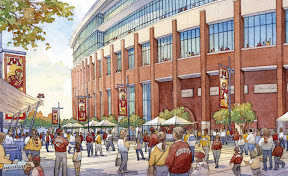 |
| From Blog Photos |
 |
| From Blog Photos |
The stadium, although requiring significant investment, will be a great new addition to campus and to the region. But most importantly for the Gophers, it will help land (hopefully) a new and exciting coach, improve recruiting, generate more revenue, and increase attendance at games. I, like many others, have liked the new East-West orientation with the open bowl that provides great views of the University of Minnesota's important neighbor Downtown Minneapolis and its signature skyline. Minnesotan's will once again have to be prepared to face the elements though with an open air stadium after enjoying the luxuries of indoor football provided at the dome, but with the way Global Warming or Global Climate Change has affected Minnesota (especially in the fall) I think we'll survive.
An added note to tack onto this post, recently in the comments a friend of mine asked how the Central Corridor would be tied into the site plan and where a possible station would go...
To answer this question I am posting the site plan that was posted on the development forum: Minnescraper by user blocksi.
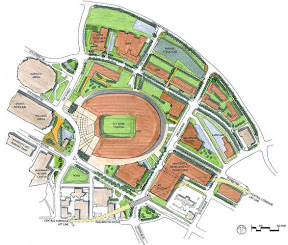 |
| From Blog Photos |
In the bottom right corner, there is a large structure to the rear of the stadium with the words: University Development Transit Hub, and on the Southwestern corner of that building is labeled a potential CC LRT station. Now, whether the CC LRT will follow this implied alignment is debatable but it is good to see the University of Minnesota is actively planning and participating with the future of CC LRT. Hope that answers the question :-D
Lot's of links with this post I guess, but oh well. Things that are new in my neck of the woods include the decision to stay at home for my final semester at the University of Minnesota. I finished Thomas E. Rick's book Fiasco. And have started reading books on Public Transportation to help with my senior thesis which for the moment I am undecided as to what to write about, however, the two topics at present are: (1)Public Transportation Policy in Minnesota and comparison to Scandinavian Public Transportation: My ISP while I was participating in the SUST program (see old posts) and possibly (2) The need for investment in High Speed Rail in the Midwest. The second topic follows closely with a string of discussion: High Speed Trains - the 21st Century Freeway System? from the Minnescraper development forum that I often frequent. Also, we are getting closer to the start of Spring Semester which means time to buy textbooks!!
On the fun side of reading I am almost finished with Eric Nyland's third book of his series involving the Halo Universe this one titled Halo:Ghosts of Onyx. I also got some books for Christmas that I am hoping to plough through including a new book by Jared Diamond as well as a book on the Cholera epidemic that plagued London in 1854 (let's hope that doesn't happen to us).
Cheers for 2007 blogoshpere!
Subscribe to:
Posts (Atom)